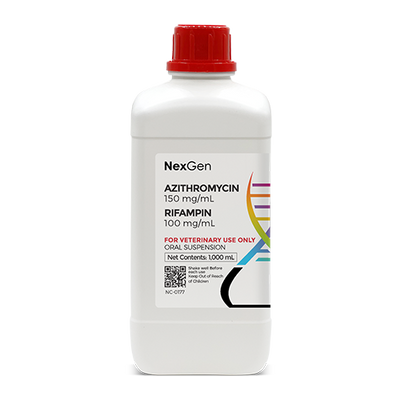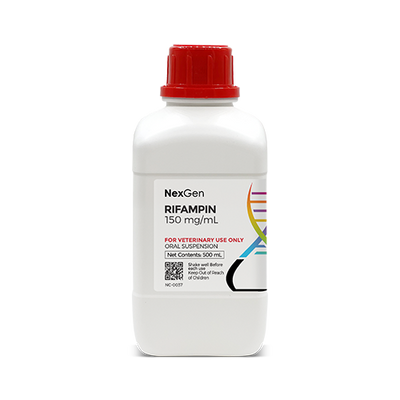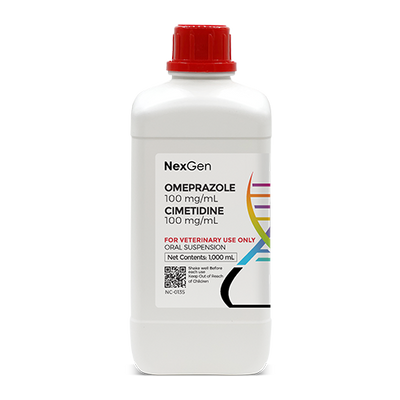
Clarithromycin 150 mg/mL + Rifampin 100 mg/mL, Oral Suspension, 1000mL
Login for pricing
- Brand
- Mixlab
- SKU:
- NC-0126
- Product Type:
- Suspension
- Size:
- 1000ml
- Administration:
- Oral
Clarithromycin 150 MG/ML / Rifampin 100 MG/ML Oral Suspension
There are myriad bacterial diseases to which horses are susceptible. While most microorganisms do not have much impact on horses, some can cause disease. Horses are exposed to bacteria on a daily basis, but in most instances, the horse’s immune system is able to fight bacterial incursions off without exhibiting any signs of sickness. Bacterial disease occurs when the horse’s immune system, weakened or just unable to fight off a high bacterial load, cannot sufficiently combat the bacteria and it becomes able to replicate and spread in the horse’s body.
Several of the more common pathogenic bacteria that affect horses include:
-
Tetanus
-
Potomac Horse Fever
-
Salmonella
-
Strangles
-
E Coli
Sources of bacteria that can ultimately cause disease in horses typically include contaminated water, food or feces. As with humans and other mammals, quite often a horse will fall prey to bacterial diseases after their immune system has already been compromised by a clinical viral infection. Horses that travel (usually performance horses) or spend a lot of time at training stables with other horses are considered to be at higher risk for bacterial infections.1 Foals and geriatric horses are more at risk for developing bacterial infections because their immune systems are weaker than those of adult horses.
“Bacterial infections present a major challenge in equine medicine. Therapy should be based on bacteriological diagnosis to successfully minimize the increasing number of infections caused by multidrug-resistant bacteria.”1 Horses that develop clinical bacterial infections will generally present with some sort of digestive upset or upper respiratory symptoms (coughing or runny nose).1,2 Fever and lethargy are often signs of bacterial infections, although viral infections can also give rise to these symptoms as well.
Strangles, for example, is a highly contagious upper respiratory infection in horses with a bacterial cause. Strangles has a low mortality rate, yet the economic ramifications due to long recovery periods can be great. Strangles is contracted through environmental contamination, nasal discharge, or direct contact with infected animals. Symptoms of strangles include high fever (103o to 106o F), cough, loss of appetite, a clear nasal discharge (which becomes yellow as the disease progresses) and difficulty in breathing and swallowing (as if strangling). Upper respiratory inflammation ultimately spreads to the submandibular lymph nodes (below the jaw), which eventually abscess and can rupture.3
Treatment of strangles encompasses supportive care, which involves keeping the animal warm and dry, isolating it from other animals, an antibiotic regimen and soft foods. Hot packing of the abscesses speeds up formation of pus.
Preventing Bacterial Infections in Horses
The first part of an infection control plan should include working with a veterinarian to develop a comprehensive vaccination program. This should be tailored to all horses at a given facility. Cleanliness practices around the barn or stable are key to keeping bacteria from spreading.4 It is a good idea for each horse to have their own supplies and grooming tools to prevent spreading germs in stables where many horses from different owners are living together.
Another component of resistance to disease is immunity (natural resistance). Stress and nutritional deficiencies (trace mineral deficiencies in particular), can result in degradation of innate immunity, so is essential to address these areas in the overall infection control plan. Horses should be as comfortable as possible during transportation and when housed; this can go a long way toward minimizing stress. Owners and managers should consider working with an equine nutritionist or veterinarian to evaluate the horse’s diet to ensure that its needs for protein, energy, vitamins and minerals are being addressed.
The second aspect of the infection control plan should focus on reducing or preventing horses’ exposure to infection causing agents. While this may seem academic, the extra physical labor required to achieve this often deters horse owners from taking the necessary steps.4
Other methods of reducing or preventing exposure of horses to bacterial agents include collecting and discarding manure frequently, segregating horses based on the risk they may pose for infectious diseases (such as horses that travel), designing facilities with segregation and infection protocols in mind, securing horse feed (to keep vermin out).
Antibiotic Treatment
Despite all precautions, horses will still occasionally come down with bacterial infections. The veterinarian will typically treat bacterial infections with antibiotic drugs; in severe cases, they may order additional support, such as fluids for dehydrated horses.
Macrolide antibiotics began with the discovery of erythromycin, which was isolated from soil bacteria in the early 1950's. Newer semi-synthethic relatives of erythromycin include claithromycin and azithromycin. Working by inhibiting the production of protein by susceptible bacteria, they may be used alone or in combination with the antibiotic, rifampin.6 The macrolide antibiotics include erythromycin, azithromycin, tylosin, tilmicosin, tiamulin and clarithromycin.
As mentioned above, macrolide antibiotics are commonly used in the treatment of disease caused by the bacteria Rhodococcus equi, which causes severe pneumonia in foals. Not only does R. equi infect the respiratory tract, causing pneumonia, it also infects the gastrointestinal tract, causing abcesses, and the joints and growth plates, causing septic conditions.6
Because resistance to rifampin can develop quickly, it is often used in combination with other antimicrobials. The bacteria listed above tend to cause abscesses, and rifampin has excellent penetration of most tissues, including bone and cerebral spinal fluid, as well as abscesses, making it a more potent drug. It is used extensively in combination with erythromycin for the treatment of Rhodococcus equi infections in foals.6
Where to buy Clarithromycin 150 MG/ML / Rifampin 100 MG/ML Oral Suspension
FOR RX ONLY: A valid prescription from a licensed veterinarian is required for dispensing this medication.
1Panchaud Y, Gerber V, Rossano A, Perreten V. Bacterial infections in horses: a retrospective study at the University Equine Clinic of Bern. Schweiz Arch Tierheilkd. 2010 Apr;152(4):176-82. doi: 10.1024/0036-7281/a000040. PMID: 20361396.
2Rush, B., DVM. Overview of Respiratory Diseases of Horses. In: Merck Veterinary Manual, Jan. 2014. https://www.merckvetmanual.com/respiratory-system/respiratory-diseases-of-horses/overview-of-respiratory-diseases-of-horses
3USDA.gov.
4aaep.org.
7cdc.gov.




















